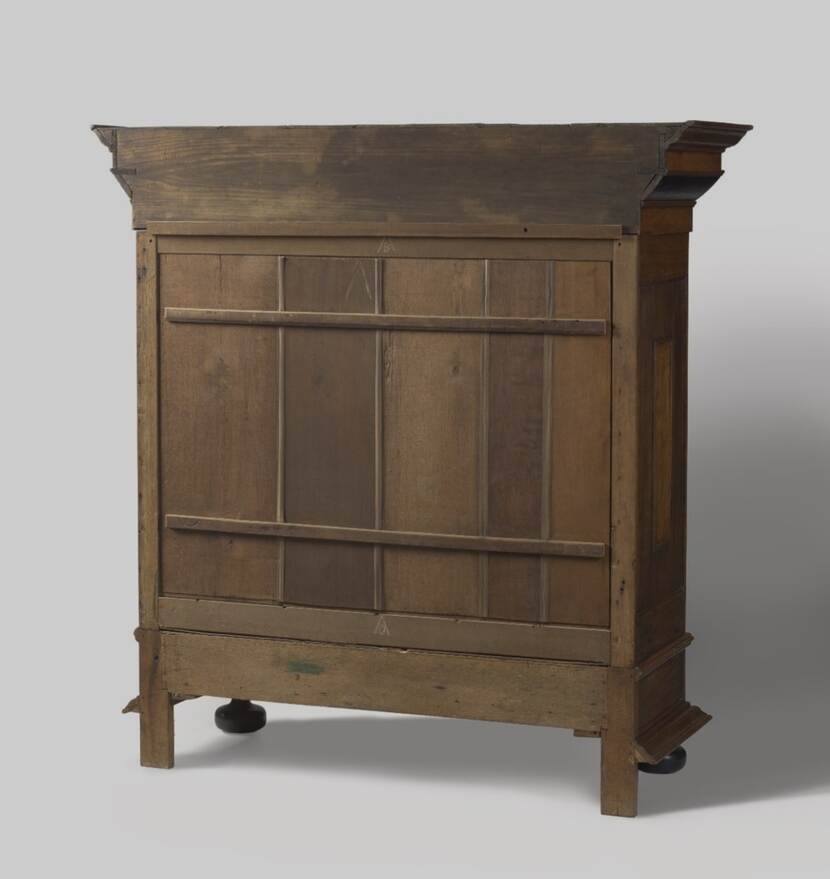In Pursuit of Provenance: an oak vine cabinet
Weblog
Every month the In Pursuit of Provenance blog discusses objects from the Netherlands Art Heritage Collection (NK Collection) on which provenance research is being carried out. This collection, among other things, comprises objects that were recovered to the Netherlands after World War II. These objects include paintings and works on paper, as well as furniture and ceramics. By giving a major boost to the research we hope to find new provenance details. This month we will look at an oak vine cabinet. Do you know anything more about the provenance of this cabinet?
The cabinet
This vine cabinet, also sometimes referred to as a cushion cabinet, is made of veneered, partly black-polished oak wood. It is decorated with carvings of flowers and leafy vines and the cabinet doors have raised ‘cushions’, which also give it its name. This type of cabinet was mainly made in the Netherlands in the 17th century and is typical of Dutch Baroque. This cabinet, however, was made in the 19th century. The maker is unknown.


The research
Until recently we knew nothing about the origins of this cabinet. It was unknown not only who the cabinet had belonged to during World War II, but also how the cabinet ended up in Germany and by what route the object was returned to the Netherlands after the war.
Because there were no leads that could be followed to research the object in the archives, the cabinet was physically examined. Using a torch we searched the drawers, the back and inside of the cabinet looking for clues, such as art trade labels. As a result, on the back of the cabinet, upside down and in small blue digits, we found the number 47304. With this clue we were able to largely trace the provenance of this cabinet.
The number is, in fact, a Munich number. A large Collecting Point was set up in Munich just after the war from where the allies sent cultural objects removed to Germany back to their country of origin. Including the Netherlands. Each object that entered the Collecting Point in Munich was given its own numbered Munich index card. These cards were kept and have recently been digitalized. This enabled us to find the Munich card with number 47304.
The provenance
The Munich index card numbered 47304 states that during the war the vine cabinet was the property of A.C. van Oosten from The Hague. We have been able to determine that this was Adrianus Cornelis van Oosten, born in Voorburg in 1892. Van Oosten had an antiques business at Noordeinde 152A. In various advertisements in the Haagsche Courant newspaper from 1940 and 1941 Van Oosten was offering antique furniture for sale from this address. He was also interested in buying home contents and antiques, including cabinets.
On 12 December 1941 Van Oosten sold the cabinet to the Münchener Kunsthandelsgesellschaft, an art dealer in Munich. The Münchener Kunsthandelsgesellschaft bought many items of furniture from various dealers in The Hague on that date. This made it clear how the cabinet had ended up in Germany during the war.
Despite the fact that new information has surfaced due to the renewed investigation, questions remain concerning the provenance of this cabinet. For example, we still know nothing about the art trading business of A.C. van Oosten or what the circumstances were surrounding the sale. Therefore we are now asking you: do you know anything more about the business of A.C. van Oosten or the further history of this cabinet?
Can you help us?
A team of provenance researchers at the Cultural Heritage Agency of the Netherlands (RCE) is working on renewed and additional provenance research on objects held in the NK Collection (The Netherlands Art Heritage Collection). Part of their work is to make the research results accessible online and to extract relevant information and data in a sustainable manner. This targeted approach gives us a clearer picture of the objects. Do you have more information about the provenance of this cabinet (NK71)? If so, please contact us via: restitutie@cultureelerfgoed.nl.
This blog was written by Simone van Wijk and Silja de Vilder Coombs, junior provenance researchers at the RCE.